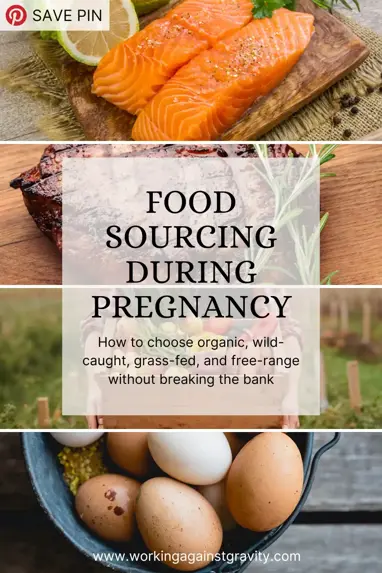
During pregnancy, your food directly impacts your health, fetal development, and your child’s health after birth. Responsible food sourcing during pregnancy is pivotal in providing the essential vitamins and minerals you and your baby need to thrive.
We’re tackling the common words and phrases you’ll come across when researching food sourcing during pregnancy, why these options are more beneficial than their conventional counterparts, and how to opt for these foods without breaking the bank.

Advertisement
Food Sourcing During Pregnancy: Buzz Phrases and Definitions
As you’ve consumed pregnancy books, articles, podcasts, and other resources, you’ve probably encountered words like organic, grass-fed, wild-caught, and free-range.
Although these foods can be more costly, picking and choosing when to spring for these high-quality options can help you optimize your nutrient intake. Need help adding these foods to your routine? WAG coaches have helped thousands of people make confident, healthy choices through the pregnancy and postpartum periods.
Organic Foods During Pregnancy
Organic foods are produced without pesticides, artificial agents, or chemical fertilizers. You eat what your food eats. Chemicals and toxins enter your body if you eat veggies sprayed with pesticides or beef from cows fed artificially modified feed [1].
Limiting exposure to pesticides and added chemicals is especially important during pregnancy as it may impact many facets of fetal development.
Picking Grass-Fed Foods for Pregnancy
Grass-fed animals forage for their food (they may be given natural foods like alfalfa in the winter if necessary) and don’t eat grains or modified feeds to increase their growth as a grain-fed animal might.
Advertisement
Meat from grass-fed animals has a better ratio of healthy fats (omega-3s) and contains more vitamins, minerals, and antioxidants than conventionally raised beef [2]. Choosing dairy products (like yogurt, cheese, and milk) from grass-fed animals also decreases the likelihood of consuming hormones and other chemicals fed to these animals [3].
During pregnancy—when hormonal health is more imperative than ever—ensuring you limit the intake of artificial hormones is essential.
Wild-Caught Fish During Pregnancy
Wild-caught fish can come from an ocean, sea, or river and are not raised in tanks, ponds, or on fish farms. Wild-caught fish have a better fatty acid profile than conventionally raised fish and may contain fewer contaminants [4].
Fish supply many vital nutrients during pregnancy, like protein, DHA, iodine, zinc, iron, vitamin B6, selenium, omega-3 fatty acids, vitamin B12, and glycine [5]. These nutrients are generally more readily available in wild-caught fish and play imperative roles in fetal development, brain health, and proper development of fine motor, social, and communication skills [6].

Advertisement
What are Free-Range Foods?
Free-range poultry like chickens and ducks are allowed to move freely in their environment and are raised under natural conditions instead of being raised in a cage on a poultry farm.
Eating eggs from free-range poultry ensures you’re not consuming the hormones and other chemicals typically fed to these animals. Free-range eggs may also contain more choline and omega-3 fats [7].
Omega-3s are a polyunsaturated fat that supports fetal growth and development, and your intake during pregnancy may influence your baby’s predisposition to diseases like diabetes later in life [8,9]. Choline helps fetal brain function and neural tube formation [10].
Food Souring During Pregnancy (On a Budget)
Cost is one of the biggest drawbacks to food sourcing during pregnancy. Organic, grass-fed, wild-caught, and free-range foods often cost more than their conventionally produced counterparts.
Advertisement
Buying food in bulk, shopping seasonally at local farmers’ markets and farm stands, joining a CSA program, growing your produce, or grabbing frozen or canned options are just a few ways to save money while buying high-quality options. Here are a few more ideas to help you eat healthy on a budget.
The Final Picture of Food Sourcing During Pregnancy
Food quality is essential when following any nutrition plan. But when nutrient intake is particularly imperative during pregnancy, sourcing food responsibly should become a top priority.
You can use the cost-saving tips above to add more organic, grass-fed, wild-caught, and free-range. If you need more support making confident nutrition choices throughout pregnancy and postpartum, a WAG Coach can help! We’ll help you navigate the daily changes in appetite, aversions, and nutrient needs to support your body and your growing little one.
References:
-
Pendick, D. (2018, Oct 9). Benefits of organic food: What research tells us. UNH University Health News. Retrieved from https://universityhealthnews.com/daily/nutrition/benefits-of-organic-food/
-
Daley, C. A., Abbot, A., Doyle, P. S., Nader, G. A., & Larson, S. (2010). A review of fatty acid profiles and antioxidant content in grass-fed and grain-fed beef. Nutr J. 9. doi: 10.1186/1475-2891-9-10
-
Malekinejad, H., & Rezabakhsh, A. (2015). Hormones in dairy foods and their impact on public health - a narrative review article. Iran J Public Health, 44(6), 742-758. Retrieved from https://www.ncbi.nlm.nih.gov/pmc/articles/PMC4524299/
-
Blanchet, C., Lucas, M., Julien, P., Morin, R., Gingras, S., & Dewailly, E. (2005). Fatty acid composition of wild and farmed Atlantic salmon (salmosalar) and rainbow trout (oncorhynchus mykiss). Lipids, 40(5), 529-31. DOI: 10.1007/s11745-005-1414-0
-
Nichols, L. (2018). Real food for pregnancy. (n.p): Lily Nichols.
-
Hibbeln, R., Davis, M., Steer, C., Emmett, P., Rogers, I., Williams, C., & Golding, J. (2007). Maternal seafood consumption in pregnancy and neurodevelopmental outcomes in childhood (ALSPAC study): an observational cohort study. Lancet, 369(9561), 578-586. doi: 10.1016/S0140-6736(07)60277-3.
-
Samman, S., Kung, F. P., Carter, L. M., Foster, M. J., Ahmad, Z. I., Phuyal, J. L., & Petocz, P. (2009). Fatty acid composition of certified organic, conventional and omega-3 eggs. Food Chemistry, 116(4), 911-914. https://doi.org/10.1016/j.foodchem.2009.03.046
-
Marangoni, F., Cetin, I., Verduci, E., Canzone, G., Giovannini, M., Scollo, P., … Poli, A. (2016). Maternal Diet and Nutrient Requirements in Pregnancy and Breastfeeding. An Italian Consensus Document. Nutrients, 8(10), 629. http://doi.org/10.3390/nu8100629
-
Morrione, T. G., & Seifter, S. (1962). ALTERATION IN THE COLLAGEN CONTENT OF THE HUMAN UTERUS DURING PREGNANCY AND POST PARTUM INVOLUTION. The Journal of Experimental Medicine, 115(2), 357–365.
-
Mennitti, L. V., Oliveira, J. L., Morais, C. A., Estadella, D., Oyama, L. M., Oller, C. M., & Pisani, L. P. (2015, February). Type of fatty acids in maternal diets during pregnancy and/or lactation and metabolic consequences of the offspring. Retrieved from https://www.ncbi.nlm.nih.gov/pubmed/25459884
Schedule a Free Intro Call
Working Against Gravity has led the macro tracking and health space for over a decade. Our team doesn’t just understand the science of nutrition—we’ve spent years mastering the art of tailoring it to fit your life. That means no cookie-cutter plans, just real strategies that have worked for over 30,000 people.
Schedule a free call with our team to learn how working with a 1-on-1 WAG coach will help you reach your goals.



